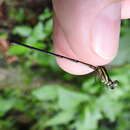Comprehensive Description
provided by Smithsonian Contributions to Zoology
Argia concinna (Rambur)
Agrion concinnum Rambur, 1842, p. 254.
Argia concinna (Rambur).—Hagen & Calvert, 1902, p. 107.— Gloyd, 1941, p. 130.
MATERIAL EXAMINED.—Dominica: d’Leau Gommier, 27 Apr. 1964, 5 1 (OF), 3 June 1964, 18 (TD), 21 Feb. 1965, 1 (JC, TC); Central Forest Reserve (small creek in forest), 28 May–2 June 1965 (DG); Laurent River north of Bells Police Station, 28 May–2 June 1965 (DG); Pont Casse, 22 May 1964 (1.3 mi east), 5 (OF), 24 May 1964 (0.4 mi east), 2 (OF),l June 1964 (1.3 mi east) 3 (TD), 6 June 1964 (1.3 mi east), 3 , 3 (TD), 15 June 1964, 1 (OF), 28 May–2 June 1965 (0.5 mi south), (DG); La Plaine, 16 Feb. 1964, 1 (HR); Fond Figues River, 16 Mar. 1964, 4 (DB), 17 Mar-1964, 2 (DB), 6 Apr. 1964, 12 , 10 (OF), 6 June 1964, 7 , 14 (TD); Laudat (creek), 28 May–2 June 1965 (DG); Springfield Estate (river), 28 May–2 June 1965 (DG); Roseau River north of Goodwill Reservoir, 28 May–2 June 1965 (DG); Castle Bruce junction, 27 Apr. 1964, 1 (OF); Clarke Hall, 21–31 Mar. 1965, 1 (WW).
This damselfly is one of the few species of Odonata endemic to the Lesser Antilles. Its identity was a mystery for several years; the type locality (“Du Cap”) was taken to mean the Cape of Good Hope, and its supposed occurrence in Africa was unique for the genus. Gloyd (1941) showed that the true locality of this species was the Lesser Antilles, mentioning that specimens from Dominica, Grenada, and Guadeloupe had been determined by her (making this species, incidentally, the only one heretofore recorded from Dominica (except from the very recently recorded Anax concolor). The mystery of the label locality has not, however, been satisfactorily solved. The possible type locality could be on Saint Lucia, where the northernmost part of the island belongs to the large Cape (or Cap) Estate, and where several small localities bear this name.
This is a conspicuous lotic species, occurring well above sea level in rushing streams.
NYMPH.—A moderately pigmented, stout nymph with heavy cadual lamellae, as is typical of the genus. Antennae 7 segmented, 3rd and 4th segments longest, 1 1/3 times the length of the 2nd. No mental and 1 lateral seta. Lateral lobe beyond movable hook bifid, mesal hook longer than lateral. Postocular lobes rounded, setose. Legs with brown, subapical femoral stripes. Infolded lateral keels on 1–5. Wing cases reaching base of 5th segment. Lamellae triangular in section, inflated, with elongate tips. Color dark, with stripes on femora and on lamellae. Length 15 mm; gills 5 mm.
The nymph was collected in a small stream.
Locality: d’Leau Gommier, 27 April 1964, collected by Flint.
- bibliographic citation
- Donnelly, Thomas W. 1970. "The Odonata of Dominica, British West Indies." Smithsonian Contributions to Zoology. 1-20. https://doi.org/10.5479/si.00810282.37

